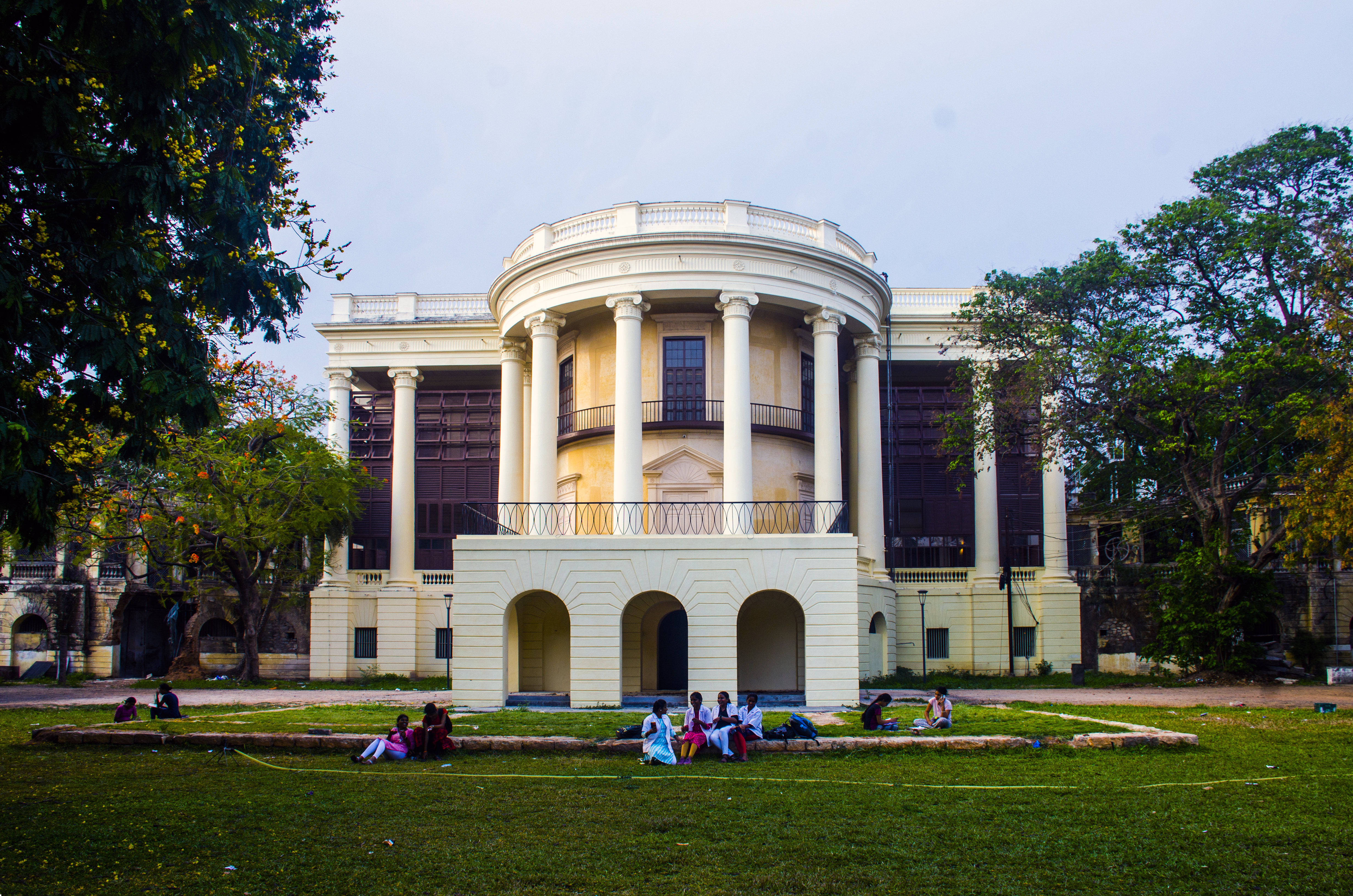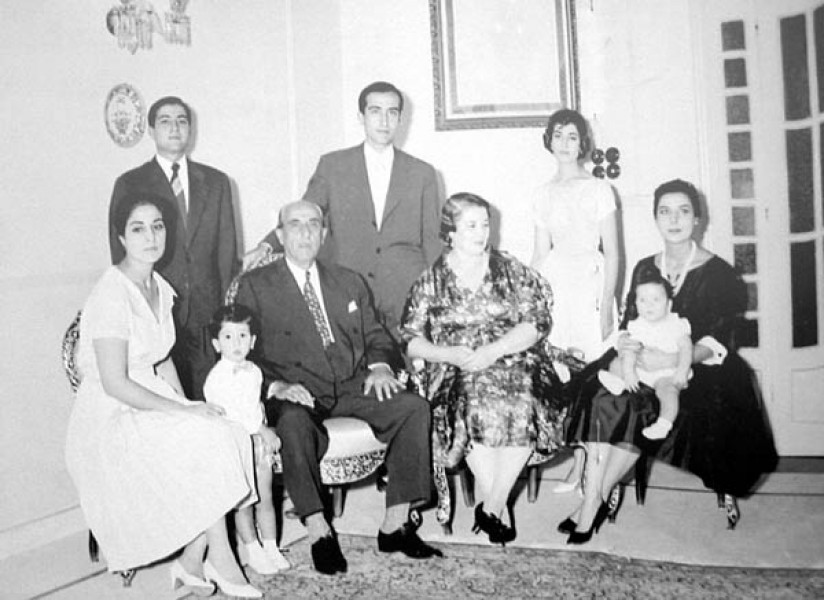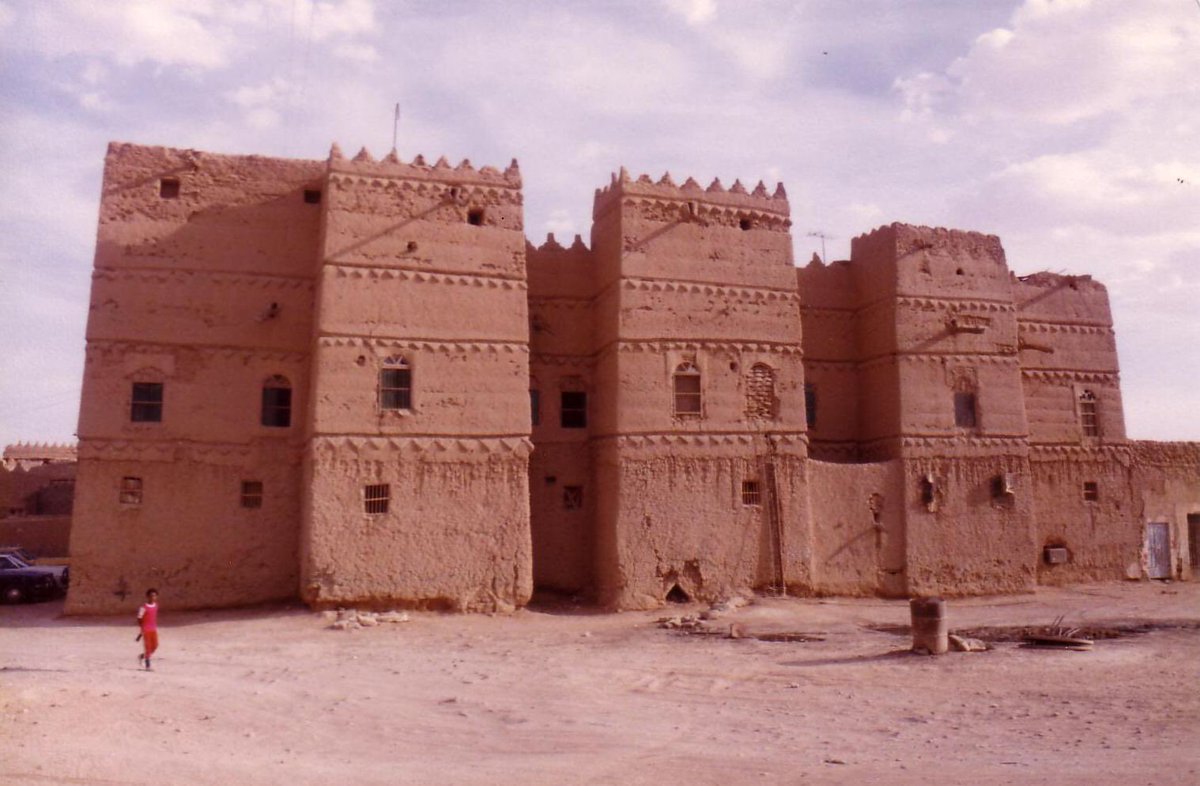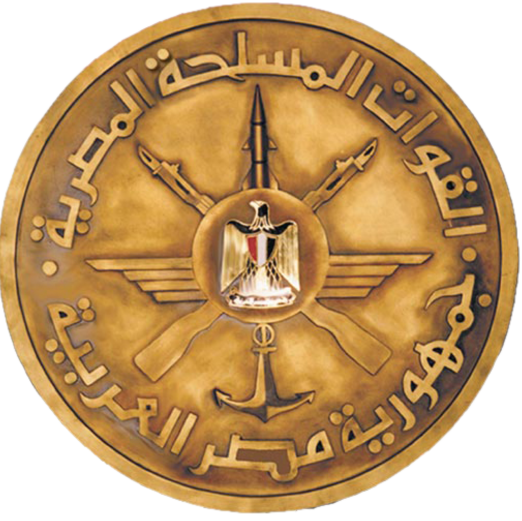|
Al Hamra Palace (Riyadh)
Al-Hamra Palace (), better known as the Red Palace () is a historic palace and a cultural landmark located in the al-Fouta neighborhood of Riyadh, Saudi Arabia. Commissioned in 1943 by King Abdulaziz ibn Saud as a gift to his son and future monarch, Prince Saud bin Abdulaziz, it served as the latter's main residence and workplace from its completion in 1948 until he moved to the al-Nassiriyah Palace in 1956. It is the first reinforced concrete structure in the history of Saudi Arabia and its layout and design were modeled after the historic British Residency building in Hyderabad, India. It was opened to the general public in 2019 after being abandoned for almost 17 years. Since 2022, the palace compound is owned by the Boutique Group, which is set to transform the building into a luxury hotel. Following the construction of al-Nassiriyah Palace in 1956, Saud handed over the premises of the palace to the Saudi Council of Ministers where it functioned as their main office ... [...More Info...] [...Related Items...] OR: [Wikipedia] [Google] [Baidu] |
Al Fouta
Al-Fouta (), alternatively transliterated as al-Futah, is a neighborhood in central Riyadh, Saudi Arabia, located south of al-Murabba and north of al-Dirah in the sub-municipality of al-Malaz. It emerged in the 1940s following the construction of the Red Palace for then Saudi crown prince Saud bin Abdulaziz. It popularly hosts the Riyadh Water Tower, one of the notable landmarks in the city as well as the rest of the southern portion of the King Abdulaziz Historical Center The King Abdulaziz Historical Center (KAHC) () is a translocational compound that includes prominent cultural and heritage landmarks in the al-Murabba and al-Futah neighborhoods of Riyadh, Saudi Arabia, encompassing the al-Murabba Palace, the N ..., including the eponymous al-Fouta Park. As the neighborhood is bounded by al-Batʼha Street to the east, its eastern strip partially forms part of the al-Batʼha commercial area. The neighborhood is unofficially divided into two sections, Fouta East () and ... [...More Info...] [...Related Items...] OR: [Wikipedia] [Google] [Baidu] |
Shukri Al-Quwatli
Shukri al-Quwatli ( ar, شكري القوّتلي, Shukrī al-Quwwatlī; 6 May 189130 June 1967) was the first president of post-independence Syria. He began his career as a dissident working towards the independence and unity of the Ottoman Empire's Arab territories and was consequently imprisoned and tortured for his activism. When the Kingdom of Syria was established, Quwatli became a government official, though he was disillusioned with monarchism and co-founded the republican Independence Party. Quwatli was immediately sentenced to death by the French who took control over Syria in 1920. Afterward, he based himself in Cairo where he served as the chief ambassador of the Syrian-Palestinian Congress, cultivating particularly strong ties with Saudi Arabia. He used these connections to help finance the Great Syrian Revolt (1925–1927). In 1930, the French authorities pardoned Quwatli and thereafter, he returned to Syria, where he gradually became a principal leader of the Na ... [...More Info...] [...Related Items...] OR: [Wikipedia] [Google] [Baidu] |
Crown Prince Of Saudi Arabia
The crown prince of Saudi Arabia is the second-most important position in Saudi Arabia, second to the King, and is his designated successor. Currently, the Crown Prince assumes power with the approval of the Allegiance Council after he is nominated by the King. This system was introduced to the country during the reign of King Abdullah. In the absence of the King, an order is issued to have the Crown Prince manage the affairs of the state until the King's return. History of the crown prince position The last crown prince of the Second Saudi State was Abdulaziz, who lost the title when Abdul Rahman bin Faisal, his father, lost his state after the Rashidis conquered Riyadh in 1890. The Al Sauds went into exile and took refuge in multiple Arab states of the Persian Gulf for nearly a decade. After the defeat at the battle of Sarif in 1900, Abdul Rahman bin Faisal gave up all ambitions to recover his patrimony. Despite this, Abdulaziz and his relatives remained determined to re ... [...More Info...] [...Related Items...] OR: [Wikipedia] [Google] [Baidu] |
Walled Town Of Riyadh
The walled town of Riyadh was the original core of Riyadh, the modern-day capital of Saudi Arabia, located on the western edge of Wadi al-Batʼha in present-day districts of ad-Dirah and ad-Doho. It succeeded from Migrin in 1746 when Dahham ibn Dawwas erected a wall around it, built a mudbrick palace for himself and ruled as the settlement's chieftain until his overthrow by the First Saudi State in 1773. It was later the center of power of the Second Saudi State for most of 19th century following brief Ottoman presence in Najd. Abdulaziz ibn Saud captured the town in 1902 and made it the base for his 30-year long unification wars that led to the establishment of Saudi Arabia in 1932. The town served as the administrative center of the Saudi government until 1944, when Ibn Saud moved his workplace and residence to Murabba Palace. In 1950, he instructed the dismantling of the fortifications in order to expand the settlement into a metropolis and the walled town eventu ... [...More Info...] [...Related Items...] OR: [Wikipedia] [Google] [Baidu] |
Murabba Palace
The Murabba Palace (Arabic: Qasr al Murabba; the Square Palace) is one of the historic buildings in Al Murabba, Riyadh, Saudi Arabia. The palace is the first building that was erected outside the walls of the old city. It was named after its square with the form of . It is one of the museums in the city. History The palace was built by King Abdulaziz outside Riyadh, being the first major expansion of the city in the twentieth century. Construction was started in 1936 and partly finalized in 1938. It was fully completed in 1945. The construction was supervised by builder Ibn Qabba, but the King also personally involved in the construction process. The palace was intended to be a family residence and court for the king. With the construction of the palace three novel technologies were introduced to the Saudi society: the use of the automobiles as means of transportation, electricity by means of generators and water closets with drainage systems. In order to connect the palace with ... [...More Info...] [...Related Items...] OR: [Wikipedia] [Google] [Baidu] |
British Residency Hyderabad 12
British may refer to: Peoples, culture, and language * British people, nationals or natives of the United Kingdom, British Overseas Territories, and Crown Dependencies. ** Britishness, the British identity and common culture * British English, the English language as spoken and written in the United Kingdom or, more broadly, throughout the British Isles * Celtic Britons, an ancient ethno-linguistic group * Brittonic languages, a branch of the Insular Celtic language family (formerly called British) ** Common Brittonic, an ancient language Other uses *'' Brit(ish)'', a 2018 memoir by Afua Hirsch *People or things associated with: ** Great Britain, an island ** United Kingdom, a sovereign state ** Kingdom of Great Britain (1707–1800) ** United Kingdom of Great Britain and Ireland (1801–1922) See also * Terminology of the British Isles * Alternative names for the British * English (other) * Britannic (other) * British Isles * Brit (other) * ... [...More Info...] [...Related Items...] OR: [Wikipedia] [Google] [Baidu] |
Jawaharlal Nehru
Pandit Jawaharlal Nehru (; ; ; 14 November 1889 – 27 May 1964) was an Indian anti-colonial nationalist, secular humanist, social democrat— * * * * and author who was a central figure in India during the middle of the 20th century. Nehru was a principal leader of the Indian nationalist movement in the 1930s and 1940s. Upon India's independence in 1947, he served as the country's prime minister for 16 years. Nehru promoted parliamentary democracy, secularism, and science and technology during the 1950s, powerfully influencing India's arc as a modern nation. In international affairs, he steered India clear of the two blocs of the Cold War. A well-regarded author, his books written in prison, such as ''Letters from a Father to His Daughter'' (1929), '' An Autobiography'' (1936) and ''The Discovery of India'' (1946), have been read around the world. During his lifetime, the honorific Pandit was commonly applied before his name in India and even today too. T ... [...More Info...] [...Related Items...] OR: [Wikipedia] [Google] [Baidu] |
Egypt
Egypt ( ar, مصر , ), officially the Arab Republic of Egypt, is a transcontinental country spanning the northeast corner of Africa and southwest corner of Asia via a land bridge formed by the Sinai Peninsula. It is bordered by the Mediterranean Sea to the north, the Gaza Strip of Palestine and Israel to the northeast, the Red Sea to the east, Sudan to the south, and Libya to the west. The Gulf of Aqaba in the northeast separates Egypt from Jordan and Saudi Arabia. Cairo is the capital and largest city of Egypt, while Alexandria, the second-largest city, is an important industrial and tourist hub at the Mediterranean coast. At approximately 100 million inhabitants, Egypt is the 14th-most populated country in the world. Egypt has one of the longest histories of any country, tracing its heritage along the Nile Delta back to the 6th–4th millennia BCE. Considered a cradle of civilisation, Ancient Egypt saw some of the earliest developments of writing, agriculture, ur ... [...More Info...] [...Related Items...] OR: [Wikipedia] [Google] [Baidu] |
Gamal Abdel Nasser
Gamal Abdel Nasser Hussein, . (15 January 1918 – 28 September 1970) was an Egyptian politician who served as the second president of Egypt from 1954 until his death in 1970. Nasser led the Egyptian revolution of 1952 and introduced far-reaching land reforms the following year. Following a 1954 attempt on his life by a Muslim Brotherhood member, he cracked down on the organization, put President Mohamed Naguib under house arrest and assumed executive office. He was formally elected president in June 1956. Nasser's popularity in Egypt and the Arab world skyrocketed after his nationalization of the Suez Canal Company and his political victory in the subsequent Suez Crisis, known in Egypt as the ''Tripartite Aggression''. Calls for pan-Arab unity under his leadership increased, culminating with the formation of the United Arab Republic with Syria from 1958 to 1961. In 1962, Nasser began a series of major socialist measures and modernization reforms in Egypt. Despite setba ... [...More Info...] [...Related Items...] OR: [Wikipedia] [Google] [Baidu] |
Lebanon
Lebanon ( , ar, لُبْنَان, translit=lubnān, ), officially the Republic of Lebanon () or the Lebanese Republic, is a country in Western Asia. It is located between Syria to the north and east and Israel to the south, while Cyprus lies to its west across the Mediterranean Sea; its location at the crossroads of the Mediterranean Basin and the Arabian hinterland has contributed to its rich history and shaped a cultural identity of religious diversity. It is part of the Levant region of the Middle East. Lebanon is home to roughly six million people and covers an area of , making it the second smallest country in continental Asia. The official language of the state is Arabic, while French is also formally recognized; the Lebanese dialect of Arabic is used alongside Modern Standard Arabic throughout the country. The earliest evidence of civilization in Lebanon dates back over 7000 years, predating recorded history. Modern-day Lebanon was home to the Phoenicians, a m ... [...More Info...] [...Related Items...] OR: [Wikipedia] [Google] [Baidu] |
Camille Chamoun
Camille Nimr Chamoun OM, ONC ( ar, كميل نمر شمعون, ''Kamīl Sham'ūn''; 3 April 1900 – 7 August 1987) was a Lebanese politician who served as President of Lebanon from 1952 to 1958. He was one of the country's main Christian leaders during most of the Lebanese Civil War (1975–1990). Early years and education Camille Nimr Chamoun was born at Deir al-Qamar on 3 April 1900 into a prominent Maronite family. He received a law degree from Saint Joseph University. Career and activities He was first elected to the Lebanese parliament in 1934, and was reelected in 1937 and 1943. A champion of independence from France, he was arrested on 11 November 1943 and was imprisoned in Rashaïa Castle, where he was held for eleven days, along with Bishara el-Khoury and Riad Al Solh, who were to become the first president and prime minister, respectively, of the new republic. Massive public protests led to their release on 22 November, which has since been celebrated as ... [...More Info...] [...Related Items...] OR: [Wikipedia] [Google] [Baidu] |
Mutawakkilite Kingdom Of Yemen
The Mutawakkilite Kingdom of Yemen ( ar, المملكة المتوكلية اليمنية '), also known as the Kingdom of Yemen or simply as Yemen, or, retrospectively, as North Yemen, was a state that existed between 1918 and 1962 in the northwestern part of what is now Yemen. Its capital was Sana'a until 1948, then Taiz. From 1962 to 1970, it maintained control over portions of Yemen (frequently most) until its final defeat in the North Yemen Civil War. Yemen was admitted to the United Nations on 30 September 1947. History Background Zaidi religious leaders expelled forces of the Ottoman Empire from what is now northern Yemen by the middle of the 17th century but, within a century, the unity of Yemen was fractured due to the difficulty of governing Yemen's mountainous terrain. In 1849, the Ottoman Empire occupied the coastal Tihamah region to put pressure on the Zaiddiyah imam to sign a treaty recognizing Ottoman suzerainty and allowing for a small Ottoman force to be ... [...More Info...] [...Related Items...] OR: [Wikipedia] [Google] [Baidu] |






